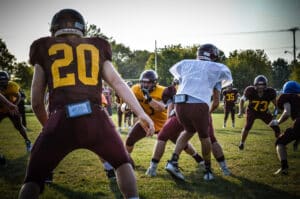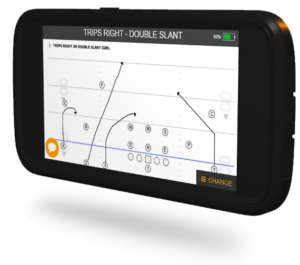14 Football Speed Drills to Accelerate Player Performance on the Field
Reading Time: 11 minutes
Reading Time: 11 minutes
Football players’ ability to react quickly, have fast feet and beat their opponents to the end zone depends strictly on speed. Therefore, a football practice must include speed drills that help players become quicker and more agile.
Football coaching gear like GoRout can also help coaches design next-level practices with increased reps and speed for a winning season. It enables coaches to optimize their football practice plan and streamline communication with players, allowing for more efficient and effective practices.
In this article, we will introduce 14 football speed drills that accelerate performance on the field and show you how to use GoRout to prepare your team for game day.
The Importance of Speed in Football
Speed in football influences both offensive and defensive plays. Fast offensive players create separation, execute precise routes and make quick decisions. Quick defensive players maintain tight coverage, rush the passer effectively and close gaps quickly to prevent big plays.
Coaches who want to learn how to coach football effectively must emphasize speed training in their practice routines. Speed dictates the game pace, creates scoring opportunities and impacts opponents’ strategies.
Incorporating speed drills into training helps players become quicker and stronger on their feet, accelerating their performance on the field.
Warm-Up Drills
Warm-up football drills prepare players for physical exertion and help prevent injuries by strengthening muscles and joints for practice and games.
Drill 1: Dynamic Stretching
Dynamic stretching is a warm-up drill to prepare the body for high-intensity activities. It increases blood flow to the muscles and boosts flexibility. Dynamic stretching means continuous, controlled movements that mimic the motions of the upcoming activity. Stretches for football players include single-leg swings, arm circles, butt kickers, walking lunges and trunk twists.
Benefits
- Improved range of motion
- Increased blood flow
- Enhanced athletic performance
Tips
Start with a light aerobic activity like jogging to raise your heart rate and warm up your muscles. Perform each stretch with control and precision. Avoid jerky or rapid movements that could lead to strain or injury. Aim for smooth, fluid motions.
Drill 2: High Knees

High knees are a fundamental football speed warm-up drill designed to increase heart rate, enhance muscle activation, and improve coordination. This exercise involves rapidly lifting the knees to hip level while maintaining a brisk pace, mimicking a running motion but with exaggerated knee lifts.
It effectively prepares the lower body muscles for the demands of more intense training. To perform high knees, athletes should stand tall with their feet hip-width apart, drive one knee towards the chest while simultaneously swinging the opposite arm, then use the opposite leg and repeat the motion continuously.
Benefits
- Cardiovascular fitness
- Muscle activation
- Coordination and football agility
Tips
Stand tall with your core engaged and your back straight for stability. Lift your knees to at least hip level with each step and pump your arms in coordination with your leg movements. Perform fast, controlled high knees with precise one-leg movements to get the most out of each rep.
Acceleration Football Speed Drills
Football acceleration drills build explosive speed and quickness, helping players burst off the line and through gaps with agility and power.
Drill 1: 10-Yard Sprints
The 10-yard sprint is a football speed drill that uses explosive acceleration and short-distance sprinting. Athletes sprint forward as fast as possible over 10 yards with quick starts and rapid acceleration.
It improves a player’s burst, which is crucial for wide receivers, running backs and linebackers. Use a crouched starting position or a three-point stance, exploding the body forward at the signal and sprinting through the 10-yard mark.
Benefits
- Explosive power output
- Improve acceleration
- Better reaction time
Tips
Start in a low stance, with your weight slightly forward and your core engaged for greater force. Drive your knees up and push off the balls of your feet. As your fitness improves, gradually increase the number of sprints and intensity.
Drill 2: Hill Sprints
A hill sprint is a high-intensity speed exercise for strength, power and endurance. It takes place on hills with moderate inclines and smooth, even surfaces. Hill sprints start with a 10-minute warm-up, then 6-10 sprints of 20-30 seconds each, with walking recovery between sprints.
Benefits
- Enhanced leg strength
- Improved power
- Increased cardiovascular endurance
Tips
Lean slightly forward and drive the knees up while pumping the arms vigorously for balance and momentum. Warm up thoroughly to prepare muscles and reduce the risk of injury. Start with a manageable number of sprints and gradually increase the volume. Make sure this exercise is done on a smooth surface for safety.
Drill 3: Resistance Band Sprints
Players perform short sprints using resistance bands as they sprint forward. These sprints typically cover distances of 10-20 yards and focus on explosive acceleration and strengthening the muscles crucial for sprinting.
Benefits
- Overall speed development
- Strength building
- Endurance
Tips
Focus on driving the knees up and maintaining a forward lean to optimize power and speed output. With proper technique, start with a manageable resistance level and gradually increase resistance as strength improves. Rest between sets to prevent fatigue-induced injuries and maintain performance quality.
Football Agility Drills
Football agility drills improve speed and agility while focusing on rapid directional changes and quick footwork on the field.
Drill 1: Cone Drills

Players use cones to navigate patterns that enhance football agility and footwork and build speed. They alternate between four cones each, execute quick cuts to the fourth cone and make a final sprint through markers in a straight line across an open field. Common cone drills include the “zig-zag,” “figure-eight,” and “T-drill.”
Benefits
- Spatial awareness
- Stronger footwork
- Conditioning and endurance
Tips
You should set up challenging patterns that require varied footwork and changing direction. Encourage players to maintain awareness while executing the same pattern and apply these skills under pressure during games. Emphasize explosive movements toward the third and fourth cones and provide rest between repetitions.
Drill 2: Ladder Drills
Speed agility drill ladders lay flat on the ground to improve foot speed and football agility. Make quick footwork patterns through the speed ladder – including high knees, two feet in each hole, a lateral shuffle and in-and-out movements. Ladder football agility drills focus on quickly placing feet shoulder-width apart and executing rapid movements through the agility ladder.
Benefits
- Quick footwork
- Increased speed
- Better coordination and balance
Tips
Players should maintain a consistent rhythm throughout the speed ladder. They stay light on their feet to perform movements swiftly and accurately. Football players move on the balls of their feet for quick, precise steps and change direction rapidly. Keep the upper body relaxed yet engaged for balance and stability. A high intensity improves conditioning and endurance.
Drill 3: Shuttle Runs
Shuttle runs improve cardiovascular fitness, speed and agility training. Players sprint back and forth between two markers while focusing on rapid acceleration, deceleration, and quickly changing direction. Variations include the 300-yard shuttle and the PACER test challenge.
Benefits
- Improved speed and agility
- Cardiovascular fitness
- Anaerobic conditioning
Tips
Football players focus on explosive starts and sharp cuts during acceleration and deceleration. They maintain good form throughout the drill—their knees drive forward, and their arms pump in sync with their stride. Variations are incorporated to challenge different aspects of speed and endurance. Consistency in training and gradual progression in distance or intensity help build stamina and performance.
Top-End Football Speed Drills
Top-end football speed drills maximize sprinting ability and allow athletes to maintain high velocity over distances.
Drill 1: Flying 30s
Flying 30s is a speed drill to better an athlete’s top-end speed and running mechanics. In this drill, athletes begin with a build-up where they gradually increase their speed over 20-30 yards. They then sprint at maximum speed for 30 yards.
Benefits
- Top-end speed
- Running mechanics
- Speed endurance
Tips
During the build-up phase, gradually increase speed for a smooth transition into the sprint segment. Keep your body relaxed, your arms pumping, and your strides quick and powerful. Stay calm and avoid tensing up to avoid losing speed.
Drill 2: Interval Sprints

Interval sprints strengthen cardiovascular fitness and build muscular endurance. Players sprint at maximum effort over a marked distance of 20 to 40 yards on a flat surface. Coaches use a stopwatch or timer to manage sprint and rest intervals. They sprint for 30 seconds, then walk or jog back to the starting point for recovery. Players repeat this cycle for 10-15 minutes.
Benefits
- Cardiovascular health
- Lower body strength and speed
- Increased endurance
Tips
Use different variations – such as reducing rest periods or longer intervals – to challenge football players further and improve performance. Use a stopwatch or interval timer to keep track of the sprint and rest periods accurately. Hydrate and cool down with static stretching for better muscle recovery and to prevent soreness.
Drill 3: Tempo Runs
This speed endurance exercise helps sustain a steady, challenging pace over a longer distance or duration. Tempo runs are performed at a controlled, brisk pace between 70-85% of maximum effort. They vary in length from 100 to 400 meters.
Benefits
- Aerobic capacity
- Higher lactate threshold
- Pacing and consistency
Tips
Choose a distance or duration that is challenging but achievable at a comfortably challenging pace. Make a consistent effort and maintain good running form throughout the run with steady breathing. This exercise is an opportunity to mentally push through discomfort.
Change of Direction Football Speed Drills
Change of direction football speed drills swiftly and efficiently alter a football player’s running path.
Drill 1: T-Drill
The T-Drill is an agility drill for lateral quickness and change-of-direction skills. Players start at the first cone of the T formation, sprint forward to the top and final cone finish line, shuffle laterally to each end of the T and backpedal to the first cone. Variations include three cones – Standard T, Reverse T and Diagonal T.
Benefits
- Speed and agility
- Acceleration and deceleration
- Body control and coordination
Tips
The body’s center of gravity is low throughout each movement phase – sprinting, shuffling and backpedaling. Ensure knees and legs are bent, and arms are active for balance and propulsion during directional changes. Use variations like the Reverse T or Diagonal T.
Drill 2: 5-10-5 Drill (Pro Agility Drill)

The 5-10-5 Drill is a cone-based pro agility shuttle that improves technique, quick feet, and balance at high speeds. Players begin in a three-point stance at the middle cone. They sprint five yards to the first cone, touch the line with their hand, and then accelerate 10 yards in the opposite direction to touch that line before sprinting back through the third cone.
Benefits
- Change direction skills
- Better balance
- Improved reaction time
Tips
Start the football agility drills with a great stance. Perfect the way players get in and out of the line. Get as far as possible from the first step towards the first cone. Always explode through the finish line. Polish steps and then work on building sprint speed.
Drill 3: L-Drill (3 Cone Drill)
The L-Drill assesses and improves a player’s quickness, sharp direction changes and body control. Three cones are arranged in an L-shape spaced 5 yards apart. This speed drill begins at one cone, where the player sprints to the middle cone and then returns to the starting cone. Sprint around the middle cone to the last cone, execute a sharp change of direction and weave back around the middle cone before sprinting back to the start.
Benefits
- Better overall speed
- Body control
- Ability to change direction rapidly
Tips
Set up the three cones in a precise L-shape with 5-yard intervals. Change direction quickly by planting your outside foot firmly and pushing off the leg explosively. Practice the drill at full speed during this exercise.
Putting It All Together

Coaches must design a practice plan that balances skill development, tactical drills and physical conditioning.
This schedule includes speed work sessions aimed at improving agility and quick decision-making. It also provides speed training, strength work and various football conditioning exercises to build endurance and create more power and resilience against injuries throughout the season.
Monitoring players’ progress through performance metrics and evaluations helps coaches fine-tune training routines and secure continuous improvement.
Tips for Maximizing Football Speed Drills Effectiveness

Here are a few tips for coaches like you looking to add football speed drills into their practices:
- Proper form and technique: Emphasize correct running mechanics and movement patterns during football speed drills to improve speed development and reduce the risk of injury. Coaches should provide real-time feedback on form during training.
- Consistency and patience: Speed improvement takes time and consistent effort. Include sprint speed drills in regular practice sessions and gradually increase intensity and complexity. Track progress using wearable technology to adjust training as needed.
- Adapt drills to each skill level: Drills should be adjusted based on players’ abilities and developmental stages. Beginners start with basic acceleration drills, while more advanced athletes incorporate complex agility training and reaction drills. Wearable technology in sports helps coaches individualize training plans based on each player’s performance data.
When it comes to improving football practice, GoRout is the best football play-calling system. Our innovative technology allows coaches to create custom play scripts and deliver them wirelessly to players on the field, maximizing practice efficiency and giving players real-time feedback.
With GoRout, coaches can easily adjust football conditioning drills and communicate with players, helping them reach their full potential.
How to Use GoRout in Football Practice
The GoRout coach-to-player communication system can revolutionize football practices by streamlining sessions, maximizing reps and preparing teams for success on the field.
With GoRout’s sports coaching technology, coaches can input and organize football coaches’ play cards, sending them instantly to player devices. It eliminates the need for huddles and significantly reduces miscommunication.
GoRout equipment is durable, easy to set up and does not require WiFi or complex configurations, making it an essential tool for coaches and teams.
Simplified scripting
Our scripting platform streamlines practic

e organization with just a few clicks. It integrates with any card drawing software, making it easy to add or edit scripts. Coaches can quickly copy or move plays between halves for well-structured practice sessions.
Coaches app
The on-field practice app, powered by GoRout STEEL technology, streamlines communication with quick and easy information exchange. Coaches can instantly snap and adjust formations on their phones, flag plays for review with a single touch and edit cards in real time using the finger drawing tool.
Player practice device

The GoRout football practice device withstands the rigors of intense practice while providing real-time feedback and communication. Players receive detailed instructions and play diagrams directly on their devices, allowing for quick execution and a better understanding of plays. This technology enhances practice efficiency by minimizing the need for huddles and maximizing reps.
Get a quote from GoRout and learn how our high-tech system can increase your reps and help your team win this season.
GoRout Success Stories

Source: GoRout
GoRout testimonials from coaches nationwide highlight how the GoRout football play-calling system has enhanced their practices and contributed to winning more games. These testimonials showcase how GoRout’s innovative technology improves team performance.
Andrews High School
“You can’t go wrong with GoRout. Saves time and energy. You get an assistant coach back who would normally be holding scout cards. It’s like adding another coach to your staff!”
Indiana University
“GoRout has helped us practice more efficiently in many ways. Our process is very very efficient with this technology. It allows both our offense and defense to be able to get a lot more reps in, and our communication is extremely improved because of the GoRout system. We love it!”
Final Words About Football Speed Drills
Speed drills help football players stay quick and agile as they run and catch the ball or guard opponents in coverage.
Technology trends in sports like GoRout devices help teams streamline communication and 3x their practice reps. Use GoRout to incorporate more football speed drills into your training for a winning season.
FAQs About Football Speed Drills
What exercises improve football speed?
Improve speed with fast feet, arms, high knees, squats, sprints and leg strengthening exercises. Check out our youth football playbook.
How to get more speed in football?
To get more speed in football, do more strength and explosive speed exercises, speed agility drills, sprinting, endurance drills and dynamic stretching.
How do NFL players train for speed?
NFL players build speed by doing football drills. Each drill improves speed, such as cone drills, footwork drills, ladder drills and leg exercises.
How can I increase my youth football speed?
Increase youth football speed with a combination of plyometrics and strength training.








